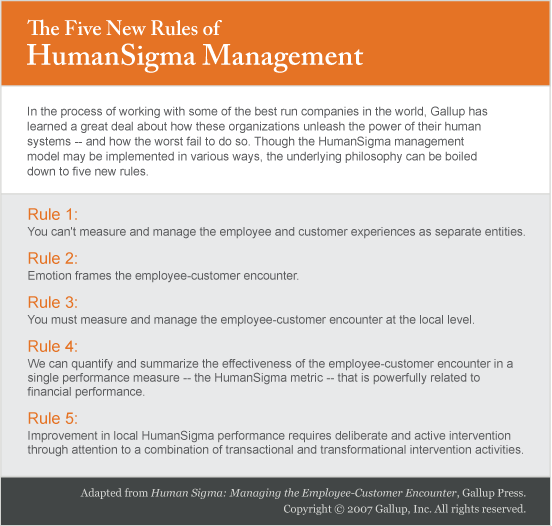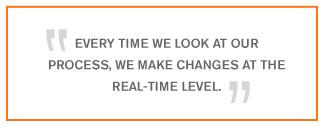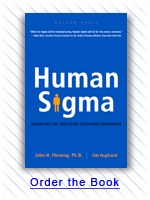Decades of research on managing the human element of business -- including interviews with more than 10 million customers and 10 million employees from around the world -- can be boiled down to five rules for getting the most out of those moments when your employees encounter your customers. So say John H. Fleming, Ph.D. and Jim Asplund, authors of Human Sigma: Managing the Employee-Customer Encounter. Their book details some of the ways the world's best performing organizations measure, manage, and improve the points of contact between their employees and customers to drive financial performance.
Studies of those companies helped shape what Fleming and Asplund deem the "Five New Rules of HumanSigma Management," which suggest a new approach for managing a company's employee-customer encounters. At a recent Gallup event that showcased the success stories of 15 organizations and their efforts to optimize their human systems, Fleming acknowledged that the companies that presented during the event were among the driving forces behind the definitions of the five rules.
This article is the first in a series on the five rules that will explore the work of some of those organizations and how they translated the rules into action. Here, we explore Rule 1: You can't measure and manage employee and customer experiences as separate entities.
Knowing your company's vital signs
In explaining the first rule, Fleming and Asplund use an analogy that should be familiar to anyone who sees a doctor for regular checkups. One of the ways physicians monitor a patient's fitness and physical health is by checking her vital signs, such as heart rate (which measures the fitness of the circulatory system) and breathing (which reflects the health of the respiratory system).
The interdependency of these two systems, the authors note, is reflected in a third vital sign -- blood pressure -- that indicates how well the two life-sustaining systems are working together. Because heart rate and respiration are interdependent, diagnosis of trouble in any of these physical functions serves as a warning sign that there might be problems with the patient's overall health.
As Fleming and Asplund assert, an organization can evaluate, regulate, and maintain its overall health by paying attention to similar vital signs that indicate performance on a number of crucial business outcomes. These indicators, based on more than 60 years of Gallup research, measure an organization's customer relationships (heart rate), employee relationships (respiration), and its overall financial performance (blood pressure). And just as people must manage their heart rate, respiration, and blood pressure to sustain human vitality, organizations must manage the interactions between employees and customers to create and sustain business performance.
As the following two organizations, ASB Bank Limited and Waste Management, Inc., demonstrate, measuring the employee-customer encounter and managing it holistically is one key to effectively implementing a HumanSigma strategy and directly affecting the financial health of an organization.
ASB Bank: making engagement a "way of life"
When the Gallup Management Journal last featured ASB Bank in 2004, Murray Beckman, the bank's chief manager, corporate development, detailed his organization's success in engaging its employees. (See "ASB Bank: Good Isn't Good Enough" in the "See Also" area on this page.) ASB Bank, a stalwart of banking in New Zealand for more than 160 years, has been administering Gallup's Q12 employee engagement survey to its associates since 2001. The commitment to measuring engagement was necessary, Beckman said during the Gallup event, because while the bank had a history of measuring staff satisfaction, it wasn't enough. "To use John [Fleming]'s idea, we were measuring the pulse of our organization, but not the true heart of the bank -- staff engagement," he said.
After some initial fears subsided, ASB dropped its 70-question employee satisfaction survey and embraced the Q12 measurement tool. Why the change of heart? "For the first time ever, we got results at the workgroup level," Beckman said. "We got results we could link to customers' outcomes, and it was powerful."
This focus on customer results is the driving force behind ASB, and nowhere is that more evident than in the bank's vision statement. "Everything we do revolves around the vision, which is 'to be New Zealand's best bank and financial services provider, excelling in customer service,'" Beckman said.

The bank's initial employee engagement results, while not what Beckman and the leaders at ASB thought they would be, gave them a sense of exactly what they needed to do to realize business performance moving forward. ASB's overall Q12 results have increased from above the 60th percentile in Gallup's worldwide employee engagement database in 2001 to above the 80th percentile in 2008. The improved results easily put the bank where Beckman thought it had been all along -- at a world-class level. "We've been at the top of almost every measure in our country that you can look at, but when our first results fell below Gallup's world-class level, we went to work," he said.
 Beckman credits organization-wide initiatives at every level of the bank for ASB's employee engagement results. The senior management and leadership throughout the organization serve as corporate champions for the engagement process, and Beckman said that ASB's associates "take engagement and make it their own."
Beckman credits organization-wide initiatives at every level of the bank for ASB's employee engagement results. The senior management and leadership throughout the organization serve as corporate champions for the engagement process, and Beckman said that ASB's associates "take engagement and make it their own."
This includes driving the process with the same passion and focus that enables them to fulfill their vision statement. And because the Q12 results capture engagement at the team level, ASB involves everyone on each team in creating detailed action plans, holding monthly one-on-one discussions, and embracing engagement activities during team meetings. (See "You've Gotten Employee Feedback. Now What?" and "What to Do With Employee Survey Results" in the "See Also" area on this page.)
Each of these tactics helps engage associates at ASB. But while improvements in voluntary turnover rates and other traditional financial indicators suggested that employee engagement was making a significant impact on ASB Bank's bottom-line performance, another set of statistics was causing concern for Beckman and others in the organization.
"We have been at the top of almost every measure and ranking in our country that you can look at among banks, but the other banks in our area were closing the gap," Beckman said. "Our employee engagement numbers had been static for the past couple of years, and we needed to find the missing piece -- the thing that would give us a quantum leap above the competition."
That something was focusing on that other vital sign -- customer engagement. "We had to get beyond satisfaction, because every other bank was focusing on that as well," Beckman said, adding that they wanted to employ a holistic approach to fulfilling ASB's vision statement. To do that, ASB needed to manage its customer and employee relationships and engagement together. Beckman asked Robyn Hart to help lead the company-wide effort. Hart, now an engagement leader at ASB, has been with the bank for more than a decade and formerly worked in the organization's human resources department. As part of Beckman's team, Hart is responsible for helping create a culture of engagement between the bank's customers and its staff.
Beginning in July 2007, any ASB Bank customer who uses the company's branch banking, rural banking, online banking, or contact center services may be asked to complete Gallup's 11-item customer engagement survey, the CE11. The bank also added some custom survey items, Hart said, that -- as with employee engagement -- enabled associates to take customer engagement and make it their own.
"We needed to create a HumanSigma philosophy within the organization, but we needed to do it our way," Hart said. "We took the staff engagement and customer engagement concepts under one umbrella that was very visible for our staff. It changed the way they thought about themselves as employees in terms of the interactions they had with their customers."
It was time for ASB Bank's customers to "get engaged" with the company's associates. The bank developed "Engaged: A Way of Life," a program dedicated to creating a culture that focuses on measuring and improving the emotional connection between ASB's staff members and their customers.
Under Hart's direction -- and again, with full support from senior-level leaders and management -- ASB developed training and communication pieces that helped the bank's associates understand what it takes to fulfill ASB's promise to its customers. This includes monthly engagement reporting and tracking at the local level, celebrating successes, and instilling a way of life throughout the organization that places value not just on customer engagement but on a comprehensive approach to the human connection.
This focus on the combined customer and employee experience has paid immediate dividends for ASB Bank, both financially and in the day-to-day encounters between its staff and its customers. "We've evolved and matured, and the company can come out and shine and share how great we are on the inside with our customers on the outside," Hart said.
Waste Management: driving performance breakthroughs
What thoughts would race through your mind if someone asked you to imagine a world without waste management? Regardless of what images that question conjures, it is safe to say that the customers of this $13 billion company rely heavily on Waste Management, Inc. and its employees. The company's leaders realize that they have a great opportunity to positively influence the organization's business results by focusing on the interactions between each employee and the 100 customers that person might interact with every day.
 But how does a business that serves nearly 20 million customers in North America -- one built on acquisitions -- create the operational stability necessary to deliver consistent, excellent experiences for its customers? According to Erica Siverson, director of employee engagement at Waste Management, the company needed to make wide-ranging organizational changes in how it hired employees, empowered managers, and engaged customers. These changes came to Waste Management through the Breakthrough Performance Leadership (BPL) program, a process rooted in the continuous improvement of business results by engaging employees and creating great customer experiences.
But how does a business that serves nearly 20 million customers in North America -- one built on acquisitions -- create the operational stability necessary to deliver consistent, excellent experiences for its customers? According to Erica Siverson, director of employee engagement at Waste Management, the company needed to make wide-ranging organizational changes in how it hired employees, empowered managers, and engaged customers. These changes came to Waste Management through the Breakthrough Performance Leadership (BPL) program, a process rooted in the continuous improvement of business results by engaging employees and creating great customer experiences.
At the Gallup event, Kelley Robinson, director of Breakthrough Performance Leadership at Waste Management, detailed the beginnings of the program, which serves as a focused management process that allows employees to help solve business problems. The program started in Florida, where Waste Management garners about 10% of its revenue and has 4,000 employees.
Although the Florida operations were profitable, a closer look at other outcomes, including turnover, revealed some challenges. "We were hemorrhaging employees; of the four thousand associates, we would lose and need to replace about two thousand each year," Robinson said. "If we could cut that turnover, we imagined just how significantly a very successful business could improve."
But the leaders at Waste Management didn't just imagine; they took action. "We looked at our recruitment and onboarding processes, because that's where we thought the problem was. However, it was really about retention and leadership and engaging our employees," Robinson said.
When the Florida operations started focusing on engagement issues, the company saw positive changes in business results in six months. To capitalize on this success -- and to start the process of creating organizational stability by boosting employee engagement throughout the company -- Waste Management defined Breakthrough Performance Leadership and piloted the program in four locations throughout the organization.
"The goal in the pilots was to validate the best practices we used in Florida," Robinson said. "This included using the Q12 employee engagement survey, which served as a way to engage our employees in a common language and communicate with them about our business results at every level."
The program received commitment from senior leadership teams and the Board of Directors, and this support facilitated two waves of pilot research and plenty of redesigns based on the research outcomes. "Every time we look at our process, we make changes at the real-time level," Robinson said. "This program is really about engagement, [which is] driving business results at every level and increasing shareholder value."
Those are vivid indicators for the leaders at Waste Management. According to Mike McInerney, the vice president of Breakthrough Performance Leadership at Waste Management, the company is committed to delivering $.25 earnings per share to its shareholders by 2010 using BPL and other programs built on the employee-customer encounter -- creating more than $250 million worth of growth. To reach this goal, the company needed to closely analyze the return on investment at the employee level and performance in other business outcomes such as turnover cost, safety, and employee engagement, McInerney said at the event.
"We're early in the employee engagement process, and we've created expectations for our employees," McInerney said. "Those expectations have resonated with some areas, and in others, we've got some work to do with the leaders. But we are on our way."
The next step for Waste Management, according to McInerney, is to continue the momentum of Breakthrough Performance Leadership in the stabilization process throughout the organization and improve employee engagement throughout the company. "We are headed toward a human capital pipeline, which is really going to provide sustainability and bring [together] all the components of talent management, succession planning, and high-level human resources strategy," he said. "By stabilizing the business, implementing employee and customer engagement strategies, and adding our human capital pipeline, we will deliver on our goal of 25 cents earnings per share."
